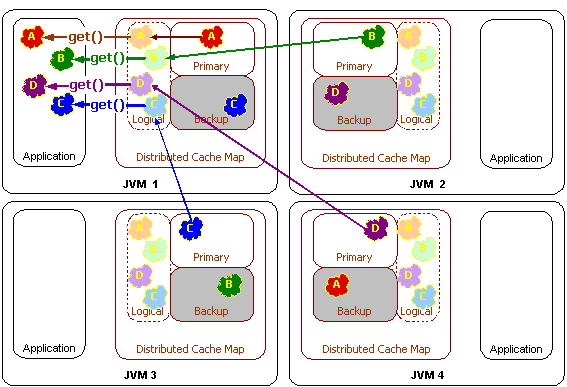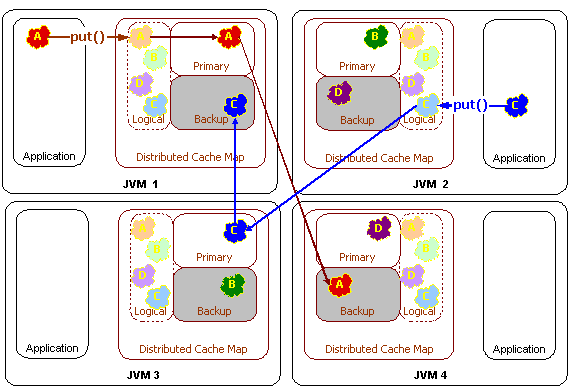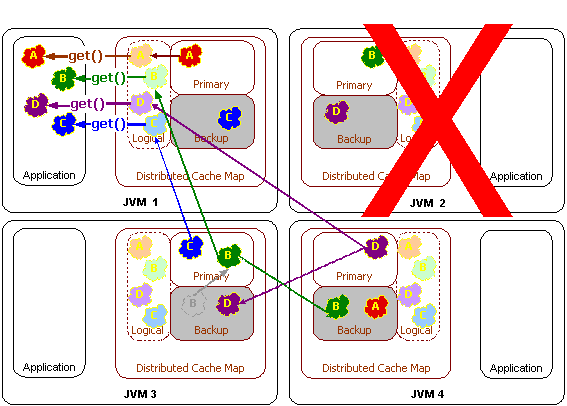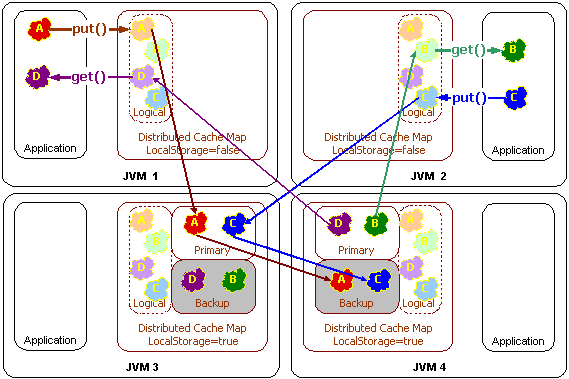15 Partitioned Cache Service
To address the potential scalability limits of the replicated cache service, both in terms of memory and communication bottlenecks, Coherence has provided a distributed cache service since release 1.2. Many products have used the term distributed cache to describe their functionality, so it is worth clarifying exactly what is meant by that term in Coherence. Coherence defines a distributed cache as a collection of data that is distributed (or, partitioned) across any number of cluster nodes such that exactly one node in the cluster is responsible for each piece of data in the cache, and the responsibility is distributed (or, load-balanced) among the cluster nodes.
There are several key points to consider about a distributed cache:
-
Partitioned: The data in a distributed cache is spread out over all the servers in such a way that no two servers are responsible for the same piece of cached data. This means that the size of the cache and the processing power associated with the management of the cache can grow linearly with the size of the cluster. Also, it means that operations against data in the cache can be accomplished with a "single hop," in other words, involving at most one other server.
-
Load-Balanced: Since the data is spread out evenly over the servers, the responsibility for managing the data is automatically load-balanced across the cluster.
-
Location Transparency: Although the data is spread out across cluster nodes, the exact same API is used to access the data, and the same behavior is provided by each of the API methods. This is called location transparency, which means that the developer does not have to code based on the topology of the cache, since the API and its behavior will be the same with a local JCache, a replicated cache, or a distributed cache.
-
Failover: All Coherence services provide failover and failback without any data loss, and that includes the distributed cache service. The distributed cache service allows the number of backups to be configured; if the number of backups is one or higher, any cluster node can fail without the loss of data.
Access to the distributed cache will often need to go over the network to another cluster node. All other things equals, if there are n cluster nodes, (n - 1) / n operations will go over the network:
Figure 15-1 Get Operations in a Partitioned Cache Environment

Description of "Figure 15-1 Get Operations in a Partitioned Cache Environment"
Since each piece of data is managed by only one cluster node, an access over the network is only a "single hop" operation. This type of access is extremely scalable, since it can use point-to-point communication and thus take optimal advantage of a switched network.
Similarly, a cache update operation can use the same single-hop point-to-point approach, which addresses one of the two known limitations of a replicated cache, the need to push cache updates to all cluster nodes.
Figure 15-2 Put Operations in a Partitioned Cache Environment

Description of "Figure 15-2 Put Operations in a Partitioned Cache Environment"
In the figure above, the data is being sent to a primary cluster node and a backup cluster node. This is for failover purposes, and corresponds to a backup count of one. (The default backup count setting is one.) If the cache data were not critical, which is to say that it could be re-loaded from disk, the backup count could be set to zero, which would allow some portion of the distributed cache data to be lost in the event of a cluster node failure. If the cache were extremely critical, a higher backup count, such as two, could be used. The backup count only affects the performance of cache modifications, such as those made by adding, changing or removing cache entries.
Modifications to the cache are not considered complete until all backups have acknowledged receipt of the modification. This means that there is a slight performance penalty for cache modifications when using the distributed cache backups; however it guarantees that if a cluster node were to unexpectedly fail, that data consistency is maintained and no data will be lost.
Failover of a distributed cache involves promoting backup data to be primary storage. When a cluster node fails, all remaining cluster nodes determine what data each holds in backup that the failed cluster node had primary responsible for when it died. Those data becomes the responsibility of whatever cluster node was the backup for the data:
Figure 15-3 Failover in a Partitioned Cache Environment

Description of "Figure 15-3 Failover in a Partitioned Cache Environment"
If there are multiple levels of backup, the first backup becomes responsible for the data; the second backup becomes the new first backup, and so on. Just as with the replicated cache service, lock information is also retained in the case of server failure; the sole exception is when the locks for the failed cluster node are automatically released.
The distributed cache service also allows certain cluster nodes to be configured to store data, and others to be configured to not store data. The name of this setting is local storage enabled. Cluster nodes that are configured with the local storage enabled option will provide the cache storage and the backup storage for the distributed cache. Regardless of this setting, all cluster nodes will have the same exact view of the data, due to location transparency.
Figure 15-4 Local Storage in a Partitioned Cache Environment

Description of "Figure 15-4 Local Storage in a Partitioned Cache Environment"
There are several benefits to the local storage enabled option:
-
The Java heap size of the cluster nodes that have turned off local storage enabled will not be affected at all by the amount of data in the cache, because that data will be cached on other cluster nodes. This is particularly useful for application server processes running on older JVM versions with large Java heaps, because those processes often suffer from garbage collection pauses that grow exponentially with the size of the heap.
-
Coherence allows each cluster node to run any supported version of the JVM. That means that cluster nodes with local storage enabled turned on could be running a newer JVM version that supports larger heap sizes, or Coherence's off-heap storage using the Java NIO features.
-
The local storage enabled option allows some cluster nodes to be used just for storing the cache data; such cluster nodes are called Coherence cache servers. Cache servers are commonly used to scale up Coherence's distributed query functionality.